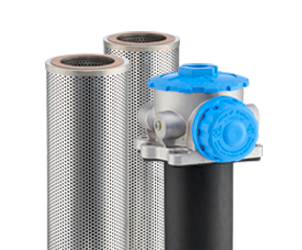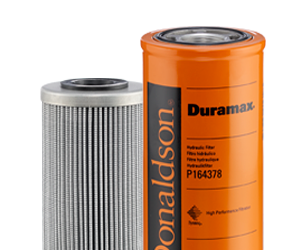In a hydraulic system, every filter performs an important function. In a perfect hydraulic system, the oil would be filtered at every stage along the circuit, before and after entering every component. In reality, cost, physical space and the need to reduce pressure to the system limit how many filters a machine can efficiently accommodate. Manufacturers design their systems to be as efficient and as cost-effective as possible.
That can mean some tough decisions about where to include filtration. The extent of filtration depends on:
- The cleanliness requirements and sensitivity of the components
- Ambient contamination
- The duty cycle of the equipment
- Ease of servicing components and replacement parts
- Other variables that vary from application to application.
- The tolerance between components (working pressure of the system)
Which type of filters are included in your hydraulic system?

Suction strainers
Typically found in the hydraulic fluid tank, their only real use is to keep insects, nuts and bolts, and other large, visible contaminants (150 micron+) out of the pump. One could argue that the need for suction strainers could be eliminated by simply pre-filtering hydraulic fluid, keeping the reservoir sealed and using a TRAP breather. However, even a small chance that large objects could find their way into a hydraulic reservoir makes the low cost of a suction strainer worth it. It could prevent extensive damage to an expensive hydraulic pump (not to mention the cost of downtime for the equipment owner). In a few instances, the suction strainer also helps to prevent air bubbles from entering the hydraulic circuit.

Low pressure or suction filters
Suction filters are normally spin-on filters placed between the reservoir and the pump and are designed to protect the pump from harmful contaminants. They are easier to service and less expensive than many other types of filters. However, to prevent restriction of the pump’s suction line, which could cause cavitation, suction filters tend to be substantially more open (larger micron size) than other “return” or “pressure” filters with the same flow rating.
High-pressure filters
These cartridge-style filters clean fluid downstream of the pump, protecting expensive components such as servo valves and actuators. High-pressure filters protect the most expensive components in the circuit in case of a catastrophic pump failure and therefore are the most critical filter (or best ROI) in the circuit. They are found in applications across most industries, from tractors to construction and mining equipment to forestry.
One disadvantage of high-pressure filters is, ironically, the high pressure. Housings for these filters must withstand pressures of 450 bar/6,500 psi, so they can be heavy-duty cast iron, difficult to handle and cumbersome to service. Unless a duplex configuration is used and strict safety practices are followed, the entire hydraulic system must be shut down to service a high-pressure filter.
You May Like...

Spin-on or cartridge style filter?
A spin-on filter’s head (the top part of the filter connected to the assembly) is threaded so it can be spun on and off the head below. The cartridge-bowl construction type involves a head and a separate housing. The element sits inside the lower, bowl portion of the housing.
Replacing a spin-on filter means throwing away the entire element. It’s a faster, simpler service, but the replacement filter elements are more expensive than those in a cartridge-bowl construction. Replacing a cartridge-bowl element results in less waste since less material is discarded, and the cost of the element is typically lower. Equipment manufacturers need to balance the trade-off between the cost to build the vehicle, the costs to operate the vehicle, the environmental impact and serviceability.
Reservoir Breathers
Breathers prevent atmospheric or airborne contamination from entering hydraulic reservoirs. Air enters the reservoir whenever the fluid level changes in the reservoir; during normal cycling of the machine and when fluid cools down during idle periods. Breathers are designed to stop particles larger than 3 micron from entering the system. Breather filters are often forgotten during service but probably offer a greater benefit for their cost than any other hydraulic filtration. They are critical components in a hydraulic system. Donaldson T.R.A.P. breathers offer both particulate and moisture removal, which is critical to long term operation and reducing operating costs.
Off-line filtration (sometimes called kidney loops)
These achieve very fine filtration by maintaining a steady-state flow that can filter fluid whether the main hydraulic system is running or not. Kidney loops are often used in critical markets where uptime is key and used to extend hydraulic drain intervals.
Unfortunately, since kidney-loop filters operate outside of the hydraulic circuit, they do not directly protect components. They also usually require a nearby source of external power.
If you own machinery, you likely own hydraulic filtration
The machine in front of you in your workshop could feature all or some of the above filter types. It is important that every owner and user of machinery with built-in hydraulic systems understand the vital preventative function of filtration — and of regular maintenance and servicing to ensure that much more expensive components within the machinery are not damaged by poor filtration. Specifying high-quality hydraulic filters — in line with the manufacturer’s individual recommendations for that machine — is not just best practice; it is usually the more economical choice for the equipment owner.
If you have any questions regarding choosing hydraulic filters, please get in touch with a Donaldson expert.
Hydraulic Filtration Overview Video





